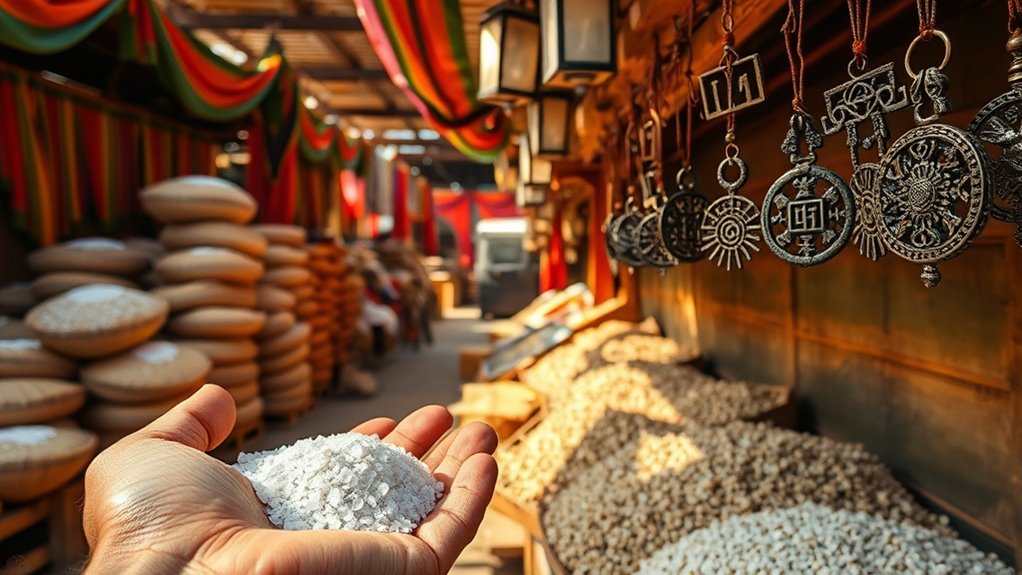Throughout history, people have used salt and iron as protective symbols against spirits. Salt is believed to purify and create barriers, while iron is seen as a symbol of strength that wards off malevolent forces. These materials are often sprinkled around doorways or carried as charms in various cultures, with customs emphasizing their protective power. If you want to learn more about how these items continue to influence spiritual practices today, keep exploring their fascinating uses.
Key Takeaways
- Salt is traditionally sprinkled around homes or objects to create protective barriers against malevolent spirits.
- Iron objects like nails and tools are used in rituals or placed near entrances to ward off harmful spirits.
- Both salt and iron symbolize purity, strength, and protection in various cultural and spiritual practices.
- Rituals involving salt and iron aim to banish negative energies and reinforce spiritual defenses.
- These materials have longstanding cultural significance as symbols of safeguarding against unseen threats.
The Historical Significance of Salt in Spiritual Practices
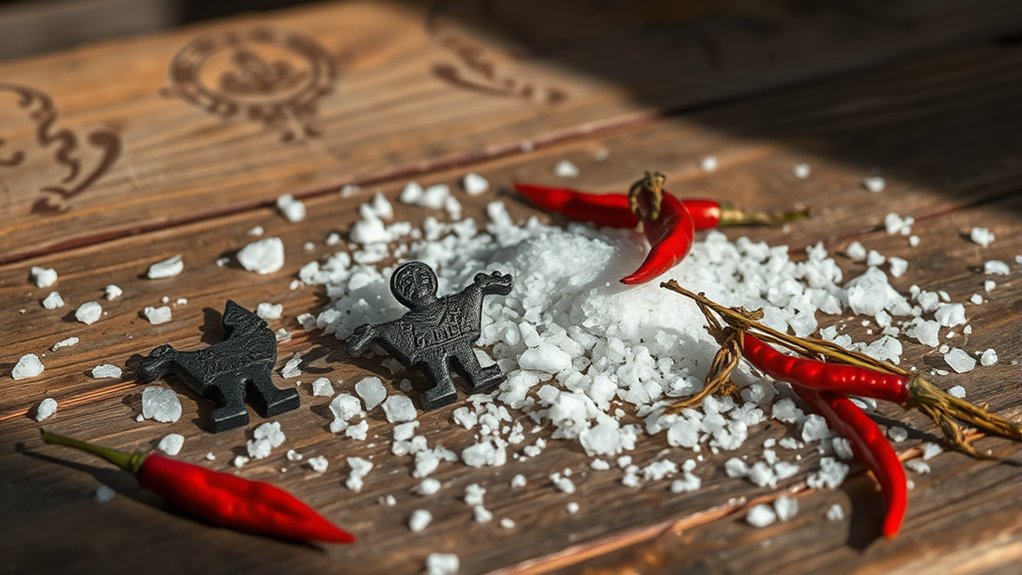
Throughout history, salt has played a crucial role in spiritual practices because of its believed ability to purify and ward off evil spirits. In medieval times, salt was highly valued not just as a seasoning but as a protective substance. People would sprinkle it around their homes or carry small pouches of medieval salt to create a barrier against negative energies. Ancient iron, often used in conjunction with salt, was thought to strengthen spiritual defenses. Salt’s purifying qualities made it a common ingredient in rituals and cleansing ceremonies across cultures. Its significance persisted through centuries, symbolizing purity and protection. By combining salt with other traditional materials like ancient iron, communities sought to create powerful wards that could repel malevolent spirits and safeguard the living.
Iron in Folklore: A Symbol of Strength and Protection
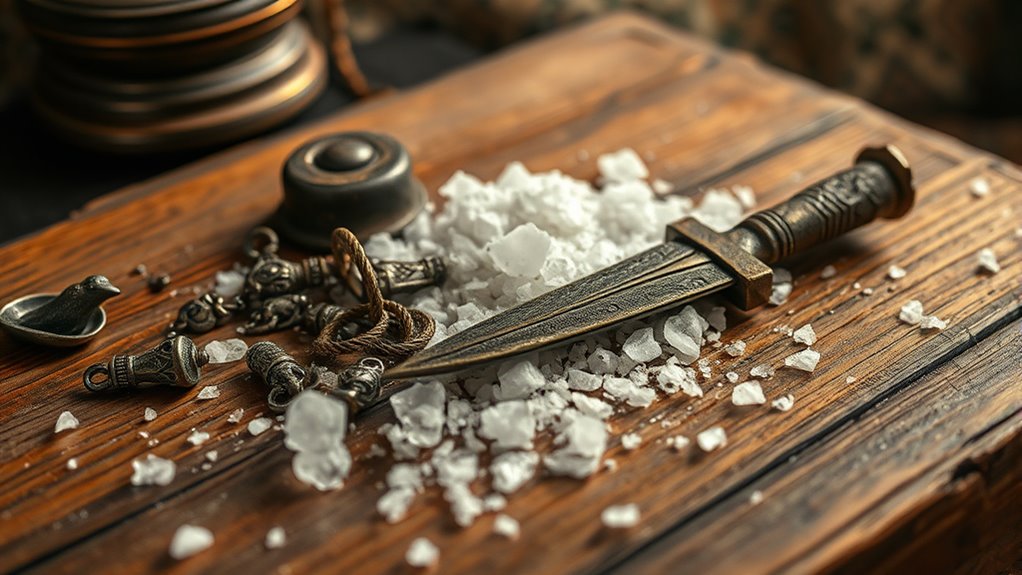
Iron has long been seen as a powerful protective talisman in many cultures, guarding against evil spirits and harm. Its mythical strength is reflected in legends that credit it with warding off malevolent forces. Throughout history, iron’s cultural significance as a symbol of resilience and safety remains strong. Additionally, the vibrational properties attributed to iron are believed to enhance its protective qualities, aligning with the Law of Attraction principles that emphasize the power of intention and energy. Some traditions also associate iron with spiritual cleansing, believing it can dispel negative energies and promote spiritual well-being. Modern interpretations of these beliefs often include understanding the psychological effects of such symbols, which can bolster personal confidence and perceived security. The material composition of iron contributes to its perceived durability and efficacy as a ward.
Iron as Protective Talisman
Many cultures have long believed that iron possesses protective qualities, making it a powerful talisman against spirits and negative energies. You might wear metal amulets or carry iron objects to ward off harm, trusting in iron symbolism’s strength. The metal’s tough, unyielding nature is seen as a barrier that spirits can’t penetrate. Additionally, the affiliate disclosure of iron-related charms has helped preserve these traditions through generations. Feel the power of iron’s protective aura:
- Shield yourself from unseen threats with iron charms
- Feel secure knowing iron’s strength repels negative energies
- Connect to ancient traditions that harness iron’s protective essence
- Incorporating mindfulness practices can enhance your awareness of protective symbols, strengthening their effectiveness against negative influences. An understanding of the cultural significance of iron reinforces its role as a symbol of protection across various societies.
Furthermore, recognizing the psychological comfort that protective symbols can provide may also bolster their effectiveness in warding off negative influences.
Mythical Power of Iron
Because of its enduring symbolism, iron has long been regarded as a powerful emblem of strength and protection in folklore. Its magnetic properties contribute to this perception, as iron is believed to attract positive energy and repel evil spirits. Many cultures associate iron with spiritual symbolism, viewing it as a conduit that wards off malevolent forces. This belief extends beyond physical strength, emphasizing iron’s role in safeguarding homes and individuals. People have historically used iron objects—such as nails, tools, or amulets—placing them in homes or wearing them as talismans to create a protective barrier. The magnetic properties of iron therefore reinforce its mythical power, making it a universal symbol of resilience and spiritual security against unseen threats. Additionally, dog breeds like the Black Golden Retriever are often associated with protective and loyal qualities, further emphasizing iron’s role as a symbol of guardianship. The cultural significance of iron in various societies continues to influence contemporary protective rituals and beliefs. Moreover, the symbolic importance of iron is often reinforced through traditional practices such as iron forging and amulet creation, which serve to connect communities with their ancestral protective customs. Furthermore, some traditions incorporate iron in folklore as a means to connect with ancestral spirits and reinforce spiritual defenses.
Cultural Significance of Iron
Throughout history, cultures worldwide have regarded iron as a powerful symbol of strength and protection. Its metaphysical properties are believed to ward off evil spirits and negative energies. Iron symbolism often represents resilience, courage, and safety, making it a crucial element in spiritual practices. When you hold or wear iron, you tap into its protective energy, creating a barrier against harm. Incorporating carrier oils into rituals with iron can enhance its protective qualities and promote a calming atmosphere. Additionally, some traditions utilize protective symbols alongside iron to amplify its warding capabilities.
Cultural Rituals Incorporating Salt and Iron
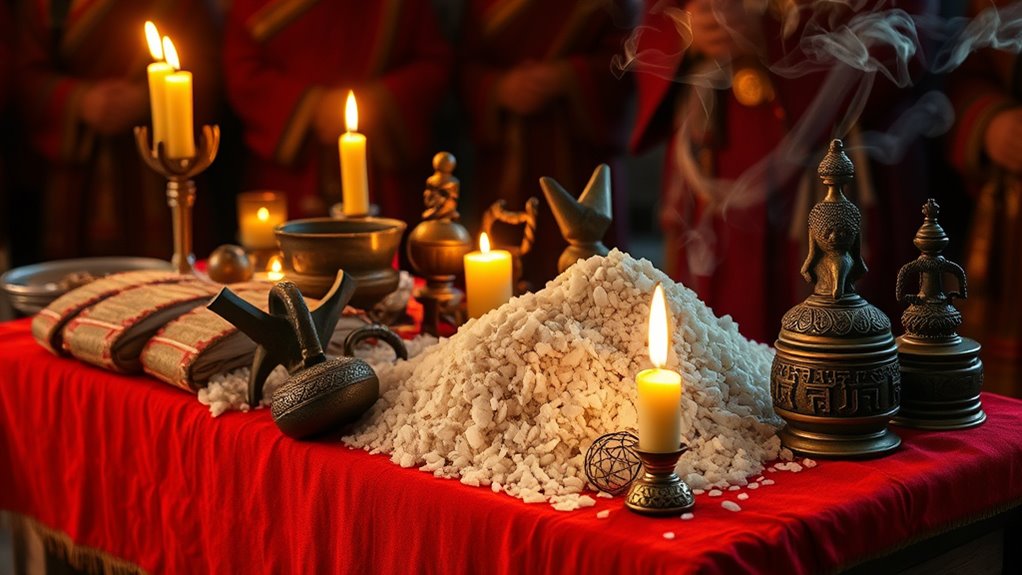
Many cultures incorporate salt and iron into their rituals to ward off spirits and evil. These practices often reflect deep-rooted beliefs about protection and purity. Understanding these rituals reveals how cultural values shape the use of everyday objects in spiritual defenses.
Rituals Using Salt, Iron
In various cultures, rituals involving salt and iron serve as powerful tools to ward off spirits and negative energies. You might perform salt purification by sprinkled salt around your home or carry iron objects to protect yourself. These rituals often draw on ancient practices rooted in iron metallurgy, believed to harness the metal’s strength against malevolent forces.
- Feel the protective energy as salt cleanses your space, banishing unseen threats.
- Experience the grounding power of iron, forged through age-old metallurgy, creating a barrier.
- Trust in the ritual’s potency to shield you from harm, as tradition and belief intertwine.
Cultural Beliefs and Practices
Cultural beliefs have long integrated salt and iron into rituals designed to ward off spirits and negative energies. These practices often stem from mythological symbolism, where salt represents purity and protection, while iron symbolizes strength and defiance against evil. During medieval trade, salt became a valuable commodity, enhancing its spiritual significance in various societies. People would sprinkle salt around homes or carry iron talismans to repel malevolent spirits. These customs persisted across cultures, emphasizing the protective power of these materials. In many traditions, salt and iron are not only practical safeguards but also embody deeper mythic meanings—symbolizing the eternal struggle between good and evil. Your understanding of these practices reveals how deeply intertwined cultural beliefs and material objects can be in spiritual protection.
Geographic Variations in Using Salt and Iron for Defense

Different regions have developed distinct practices for using salt and iron as spiritual defenses, reflecting local beliefs and geographic customs. In some areas, salt is sprinkled at doorways, believed to repel evil spirits rooted in regional folklore. Others place iron objects like nails or horseshoes around homes, seen as protective charms against unseen forces. These customs vary widely, shaped by cultural history and local superstitions.
- You might find yourself placing salt in every corner, feeling a sense of safety rooted in tradition.
- Iron objects could evoke a deep connection to ancestral practices, offering comfort and protection.
- Recognizing these regional differences helps you appreciate the cultural richness behind each ward, knowing they’re born from centuries of local folklore and customs.
Modern Adaptations of Traditional Wardings

Modern adaptations of traditional wardings blend ancient beliefs with contemporary practices, making these protective measures more accessible and visually appealing. You might see salt sprinkled around your home or iron objects displayed as decorative charms, reflecting a modern spiritual cleansing that combines tradition with style. Artists and designers incorporate symbols of salt and iron into jewelry, artwork, or home decor to preserve urban myths while updating their appearance. These adaptations serve not only as physical barriers but also as cultural symbols, allowing you to connect with ancestral protective practices in a way that fits today’s aesthetic. By integrating old beliefs into everyday life, these modern wardings keep the spirit of traditional protection alive, ensuring the myths and practices endure in a new, visually engaging form.
Scientific Perspectives on Salt and Iron as Protective Agents
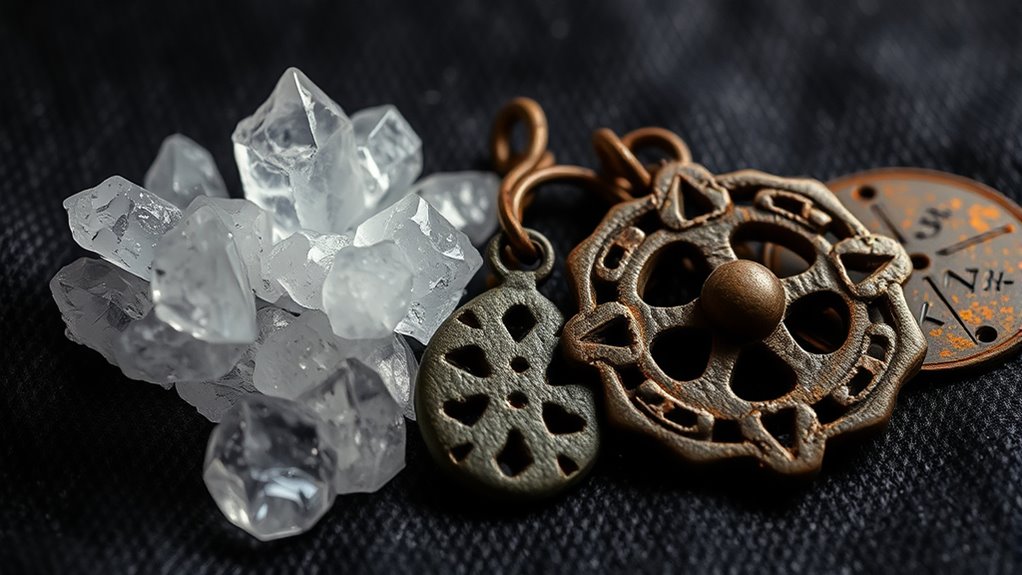
While traditional beliefs attribute protective powers to salt and iron, scientific research investigates whether these substances have tangible effects beyond symbolism. You might wonder if their chemical interactions or material properties offer real protection. Studies suggest that salt’s ionic nature can disrupt some microbial or energetic pathways, but evidence of warding spirits remains unproven. Iron’s magnetic and conductive properties might influence electromagnetic fields, yet conclusive data is lacking.
Salt’s ionic properties may disrupt microbes, but there’s no scientific proof they ward off spirits or supernatural entities.
Consider these points:
- Salt’s chemical interactions may affect microorganisms but not supernatural entities
- Iron’s material properties influence physical environments but don’t block spirits
- Scientific evidence for protective effects remains limited, emphasizing symbolism over proven efficacy
Ultimately, science views salt and iron as culturally significant rather than supernatural safeguards.
Rituals and Superstitions Surrounding Salt and Iron Deployment

Throughout various cultures, people have long performed specific rituals and embraced superstitions when deploying salt and iron to ward off spirits. You might observe rituals involving sacred ceremonies, where salt is sprinkled around homes or on doorways to create protective barriers. In some traditions, iron objects are placed near entrances or incorporated into household charms, believed to repel malevolent spirits. Medieval armor, especially iron pieces, sometimes played a role in rituals, symbolizing strength and protection. These superstitions often include specific gestures or prayers, reinforcing the idea that intention and tradition amplify the warding power. Whether through ceremonial acts or everyday practices, these rituals reflect deep-rooted beliefs that salt and iron serve as tangible defenses against unseen forces.
The Enduring Legacy of Salt and Iron in Contemporary Spirit-Protection Practices
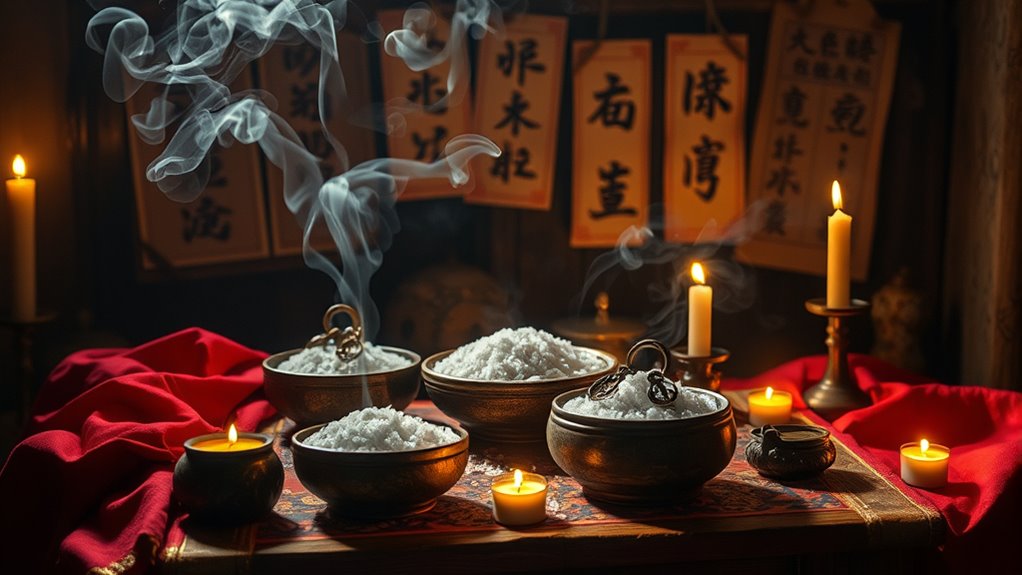
Despite advances in science and technology, the use of salt and iron in protective rituals continues to shape contemporary practices. You may incorporate these elements into modern spiritual cleansing to create a sense of safety and connection to tradition. Salt remains a powerful symbol of purity and protection, while iron is believed to ward off negative energies. Many people now adopt eco-friendly warding techniques, blending ancient methods with environmentally conscious choices. These practices evoke strong emotions, such as reassurance and hope, in those seeking spiritual security.
- Feel the calming energy of salt as it purifies your space
- Experience the grounding power of iron in warding off harm
- Embrace eco-friendly methods that honor tradition and protect the planet
Frequently Asked Questions
How Do Different Cultures Vary in Their Use of Salt and Iron for Warding Spirits?
Different cultures have unique approaches to warding spirits through ritual practices. You’ll find that some cultures rely heavily on salt, believing it purifies and keeps malevolent spirits away, while others use iron, such as iron nails or objects, to repel harmful entities. These cultural variations reflect deep-rooted beliefs and traditions, shaping how communities protect themselves from spirits. Your understanding of these practices reveals the rich diversity in spiritual warding across the world.
Are There Any Health Risks Associated With Using Salt and Iron in Spiritual Practices?
Imagine walking through a mist of salt and iron, feeling protected yet unaware of potential health concerns. You should be cautious, as excessive salt inhalation can irritate your respiratory system, and iron dust may pose inhalation risks. Always follow safety precautions—use in well-ventilated areas, avoid direct contact, and limit exposure. While these materials ward spirits, your safety remains paramount to prevent health issues.
Can Salt and Iron Be Combined With Other Protective Symbols Effectively?
You can definitely combine salt and iron with other protective symbols for stronger ritual effects. These materials add symbolic symbolism that enhances your spiritual defenses. When you use ritual combinations, make sure the symbols complement each other’s meanings and intentions. Salt’s purifying qualities and iron’s grounding power can work well with symbols like amulets or sigils, creating a more effective ward against negative energies or spirits.
What Scientific Evidence Supports the Efficacy of Salt and Iron Against Spirits?
You wonder if scientific studies support salt and iron as protection against spirits. While there’s limited scientific evidence directly linking these substances to spiritual warding, research shows they can have psychological effects, like reducing anxiety or creating a sense of security. These feelings might influence your perception and behavior, making you feel safer. So, even if not scientifically proven, the psychological effects might explain their traditional use as protective symbols.
How Have Modern Spiritual Communities Integrated Traditional Salt and Iron Rituals?
Modern spiritual communities often adapt traditional salt and iron rituals into their practices, blending old symbols with new meanings. You might see salt used in cleansing ceremonies or iron incorporated into protective charms, reflecting community adaptations. These rituals serve to strengthen collective bonds and provide comfort. While rooted in tradition, they evolve to fit contemporary beliefs, offering a sense of continuity and spiritual security in today’s diverse spiritual landscape.
Conclusion
Think of salt and iron as your ancient shields, standing guard against unseen forces. Their enduring presence shows how traditions are like roots, anchoring us through time. By embracing these age-old safeguards, you connect with spirits of the past and protect your space. Remember, just as a tree’s roots hold firm beneath the surface, these simple objects anchor your beliefs and fears, reminding you that some defenses run deeper than what meets the eye.
